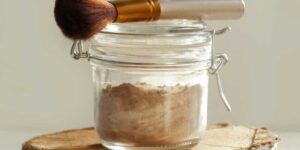Table of Contents
DIY Dry Shampoo: Fresh Hair Without Water
We’ve all had those moments when we’re in a hurry, needing to freshen up our hair but lacking the time for a full wash. While dry shampoo offers a convenient solution, there are healthier alternatives to store-bought options that you can easily make at home. In this guide, we’ll explore the benefits, ingredients, and steps for creating a DIY dry shampoo tailored to your needs.
What Is Dry Shampoo?
Dry shampoo is a water-free hair care solution designed to refresh hair by absorbing oils, sweat, and dirt. It comes in spray or powder form and is applied directly to the scalp and roots. Originally popularized in the 1940s, dry shampoo has evolved into a quick fix for many, offering a clean look without the need for water.

DIY Dry Shampoo: A Healthier Alternative
Benefits of Using Dry Shampoo
- Quick and convenient hair refresh without water
- Reduces the frequency of traditional shampooing, which can help protect natural oils
- Helps with maintaining hairstyles by adding volume and reducing greasiness
How Does Dry Shampoo Work?
The main function of dry shampoo is to absorb excess oil in the hair, helping it look cleaner and fuller. Ingredients like starches, clays, or powders soak up oils and impurities, giving a fresh look to hair between washes. Some dry shampoos also contain fragrances to mask any unwanted odors, adding a refreshing scent.
Popular Ingredients in Commercial Dry Shampoos
Many commercial dry shampoos contain ingredients that are not always beneficial for hair health, including chemicals that can cause build-up. Instead of relying on store-bought products, creating your own version at home allows you to control the ingredients, making it a healthier choice for your hair and scalp.
DIY Dry Shampoo Recipe
Making dry shampoo at home is surprisingly easy and allows you to use natural ingredients that suit your hair color and type. Here’s a simple recipe for a DIY dry shampoo, along with the benefits of each ingredient.
Ingredients
- Arrowroot Powder or Cornstarch: For lighter hair colors, arrowroot or cornstarch helps absorb oil without adding any noticeable color.
- Cocoa or Cinnamon Powder: For darker hair, cocoa powder or cinnamon blends well without leaving a white residue. Cocoa can also add a pleasant fragrance.
- Essential Oils: Lavender and peppermint oils provide a refreshing scent and come with hair-boosting properties. Lavender has antimicrobial effects, while peppermint oil is an antiseptic and energizes the scalp.
DIY Dry Shampoo Instructions
- Mix arrowroot powder or cornstarch with cocoa or cinnamon powder in a bowl. Adjust based on your hair color.
- Add a few drops of lavender or peppermint essential oil for added benefits.
- Apply to your scalp using a clean makeup brush, targeting the roots.
- Let it sit for a few minutes, then brush or blow-dry your hair to distribute the powder evenly.
Benefits of DIY Dry Shampoo
Using DIY dry shampoo allows you to avoid synthetic ingredients often found in commercial products. Arrowroot powder, for example, is harvested without chemicals, making it a cleaner choice than cornstarch. The essential oils used are rich in nutrients that promote hair health, adding antimicrobial and stimulating properties to your hair care routine.
When to Use Dry Shampoo
Dry shampoo is a convenient option for busy days, especially for people who work out frequently or have tight schedules. However, it’s not a replacement for regular hair washing. Using it sparingly helps maintain a healthy balance, as overuse can lead to scalp buildup.
Who Can Benefit from Dry Shampoo?
Dry shampoo is suitable for almost everyone, from busy professionals to athletes. It’s especially useful for preserving certain hairstyles, as hair stylists often recommend avoiding a full wash before creating certain updos.
Risks and Side Effects of Overusing Dry Shampoo
While dry shampoo is a great time-saver, using it excessively can lead to scalp buildup, which may cause irritation or dullness. It’s essential to wash your hair with regular shampoo and water after a few applications to remove any residue.
How to Avoid Product Buildup
To keep your scalp and hair in optimal condition, try alternating between dry shampoo and water washes. Regular cleansing allows your scalp to breathe and prevents issues associated with excess oil or dry shampoo residue.
Conclusion
DIY dry shampoo is an excellent alternative for those seeking a natural, cost-effective hair care option. By using simple, natural ingredients tailored to your hair type, you can refresh your hair without exposing it to harsh chemicals. Remember to use it moderately, and always return to a thorough wash to maintain scalp health.
For more information on hair care and the best practices, explore reputable resources like Healthline and Mayo Clinic.